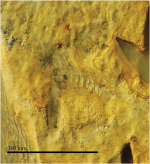albertonykus
Well-known member
Fleury, K., E. Burns, M. Richards, K. Norton, S. Read, R. Wesley, R.E. Fordyce, and K. Wilcken (2023)
The moa footprints from the Pliocene–early Pleistocene of Kyeburn, Otago, New Zealand
Journal of the Royal Society of New Zealand (advance online publication)
doi: 10.1080/03036758.2023.2264789
In March, 2019, a trackway of seven footprints was found at a riverbank outcrop of Maniototo Conglomerate Formation in the Kyeburn River, Central Otago, South Island, New Zealand. In this study, we describe this first known occurrence of moa (Dinornithiformes) footprints to be found and recovered in Te Waipounamu/South Island. Footprints of the trackway were ∼46 mm deep, 272–300 mm wide and 260–294 mm in length. An associated separate footprint was 448 mm wide and 285 mm long. Cosmogenic nuclide dating of adjacent overlying beds from the same formation establishes a mean minimum age of burial age for the tracks of 3.57 Ma (+1.62/−1.18 Ma) with a mode of 2.9 Ma, which we interpret to be Late Pliocene, with a conservative age range of Pliocene to Early Pleistocene. The trackway maker is identified as a moa from the Emeidae family, probably from the genus Pachyornis, with a mean mass of 84.61 kg that was travelling at a speed of 2.61 kmh−1. The single adjacent footprint was made by an individual from the family Dinornithidae, most likely from the genus Dinornis with an estimated mass of 158 kg. These moa footprints represent the second earliest fossil record of moa.
The moa footprints from the Pliocene–early Pleistocene of Kyeburn, Otago, New Zealand
Journal of the Royal Society of New Zealand (advance online publication)
doi: 10.1080/03036758.2023.2264789
In March, 2019, a trackway of seven footprints was found at a riverbank outcrop of Maniototo Conglomerate Formation in the Kyeburn River, Central Otago, South Island, New Zealand. In this study, we describe this first known occurrence of moa (Dinornithiformes) footprints to be found and recovered in Te Waipounamu/South Island. Footprints of the trackway were ∼46 mm deep, 272–300 mm wide and 260–294 mm in length. An associated separate footprint was 448 mm wide and 285 mm long. Cosmogenic nuclide dating of adjacent overlying beds from the same formation establishes a mean minimum age of burial age for the tracks of 3.57 Ma (+1.62/−1.18 Ma) with a mode of 2.9 Ma, which we interpret to be Late Pliocene, with a conservative age range of Pliocene to Early Pleistocene. The trackway maker is identified as a moa from the Emeidae family, probably from the genus Pachyornis, with a mean mass of 84.61 kg that was travelling at a speed of 2.61 kmh−1. The single adjacent footprint was made by an individual from the family Dinornithidae, most likely from the genus Dinornis with an estimated mass of 158 kg. These moa footprints represent the second earliest fossil record of moa.






